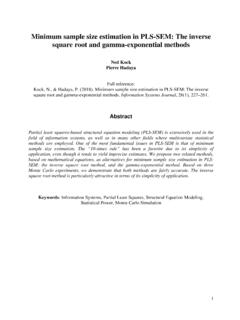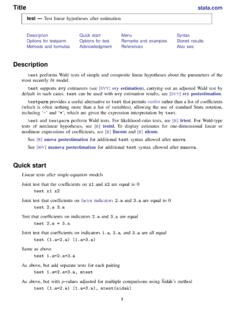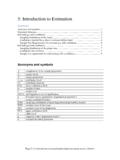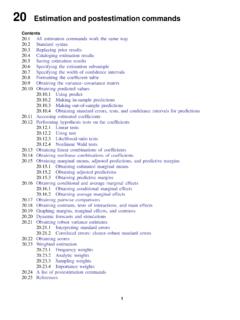Transcription of Lecture 9: Logit/Probit
1 Lecture 9: Logit/ProbitProf. Sharyn O Halloran Sustainable Development U9611 Econometrics IIReview of Linear estimation So far, we know how to handle linearestimation models of the type:Y = 0+ 1*X1+ 2*X2+ .. + X + Sometimes we had to transform or add variables to get the equation to be linear: Taking logs of Y and/or the X s Adding squared terms Adding interactions Then we can run our estimation , do model checking, visualize results, estimation In all these models Y, the dependent variable, was continuous. Independent variables could be dichotomous (dummy variables), but not the dependent var. This week we ll start our exploration of non-linear estimation with dichotomous Y vars.
2 These arise in many social science problems Legislator Votes: Aye/Nay Regime Type: Autocratic/Democratic Involved in an Armed Conflict: Yes/NoLink Functions Before plunging in, let s introduce the concept of a link function This is a function linking the actual Y to the estimated Y in an econometric model We have one example of this already: logs Start with Y = X + Then change to log(Y) Y = X + Run this like a regular OLS equation Then you have to back out the resultsLink Functions Before plunging in, let s introduce the concept of a link function This is a function linking the actual Y to the estimated Y in an econometric model We have one example of this already.
3 Logs Start with Y = X + Then change to log(Y) Y = X + Run this like a regular OLS equation Then you have to back out the resultsDifferent s hereLink Functions If the coefficient on some particular X is , then a 1 unit X (Y ) = [log(Y))]= e (Y) Since for small values of , e 1+ , this is almost the same as saying a % increase in Y (This is why you should use natural log transformations rather than base-10 logs) In general, a link function is some F( ) F(Y) = X + In our example, F(Y) = log(Y)Dichotomous Independent Vars. How does this apply to situations with dichotomous dependent variables?
4 , assume that Yi {0,1} First, let s look at what would happen if we tried to run this as a linear regression As a specific example, take the election of minorities to the Georgia state legislature Y = 0: Non-minority elected Y = 1: Minority electedDichotomous Independent Re presen tative Electe Vo tin g A ge Pop ulationThe data look like only values Y can have are 0 and 1 Dichotomous Independent here s a linear fit of the dataNote that the line goes below 0 andabove Voting Age PopulationBla ck Re presen tative Ele cte dFitte d value sDichotomous Independent line doesn t fit the data very if we take values of Y between 0 and 1 to be probabilities, this doesn t make Voting Age PopulationBla ck Re presen tative Ele cte dFitte d value sRedefining the Dependent Var.
5 How to solve this problem? We need to transform the dichotomous Y into a continuous variable Y (- , ) So we need a link functionF(Y) that takes a dichotomous Y and gives us a continuous, real-valued Y Then we can runF(Y) = Y = X + Redefining the Dependent the Dependent as aProbability01 Redefining the Dependent as aProbability01Y (- , )?- Redefining the Dependent Var. What function F(Y) goes from the [0,1] interval to the real line? Well, we know at least one function that goes the other way around. That is, given any real value it produces a number (probability) between 0 and 1. This is the Dependent Var.
6 What function F(Y) goes from the [0,1] interval to the real line? Well, we know at least one function that goes the other way around. That is, given any real value it produces a number (probability) between 0 and 1. This is the cumulative normal distribution That is, given any Z-score, (Z) [0,1]Redefining the Dependent Var. So we would say thatY = (X + ) 1(Y) = X + Y = X + Then our link function is F(Y) = 1(Y) This link function is known as the Probitlink This term was coined in the 1930 s by biologists studying the dosage-cure rate link It is short for probability unit probit EstimationAfter estimation , you can back out probabilities using the standard normal EstimationSay that for a given observation, X = EstimationSay that for a given observation, X = EstimationSay that for a given observation, X = EstimationSay that for a given observation, X = -1 Prob(Y=1)
7 EstimationSay that for a given observation, X = EstimationSay that for a given observation, X = EstimationSay that for a given observation, X = 2 Prob(Y=1) probit estimation In a probit model, the value of X is taken to be the z-value of a normal distribution Higher values of X mean that the event is more likely to happen Have to be careful about the interpretation of estimation results here A one unit change in Xileads to a ichange in the z-scoreof Y (more on this ) The estimated curve is an S-shaped cumulative normal distributionProbit estimation This fits the data much better than the linear estimation Always lies between 0 and of Electing a Black Voting Age PopulationProbit estimation Can estimate, for instance, the BVAP at which Pr(Y=1) = 50% This is the point of equal opportunity of Electing a Black Voting Age PopulationProbit estimation Can estimate, for instance, the BVAP at which Pr(Y=1)
8 = 50% This is the point of equal opportunity of Electing a Black Voting Age PopulationProbit estimation Can estimate, for instance, the BVAP at which Pr(Y=1) = 50% This is the point of equal opportunity of Electing a Black Voting Age PopulationProbit estimation This occurs at about 48% of Electing a Black Voting Age PopulationRedefining the Dependent Var. Let s return to the problem of transforming Y from {0,1} to the real line We ll look at an alternative approach based on the odds ratio If some event occurs with probability p, then the oddsof it happening are O(p) = p/(1-p) p = 0 O(p) = 0 p = O(p) = 1/3 ( Odds are 1-to-3 against ) p = O(p) = 1 ( Even odds ) p = O(p) = 3 ( Odds are 3-to-1 in favor ) p = 1 O(p) = Redefining the Dependent Var.
9 So taking the odds of Y occuring moves us from the [0,1] as aProbability01 Redefining the Dependent Var. So taking the odds of Y occuring moves us from the [0,1] interval to the half-line [0, ) 01 OriginalYY as aProbability01 Odds of Y 0 Redefining the Dependent The odds ratio is always non-negative As a final step, then, take the logof the odds ratio01 OriginalYY as aProbability01 Odds of Y 0 Redefining the Dependent as aProbability01 Odds of Y 0 Log-Odds of Y- Logit Function This is called the logit function logit(Y) = log[O(Y)] = log[y/(1-y)] Why would we want to do this? At first, this was computationally easier than working with normal distributions Now, it still has some nice properties that we ll investigate next time with multinomial dep.]
10 Vars. The density function associated with it is very close to a standard normal distributionLogit vs. logit function is similar, but has thinner tails than the normal distributionLogit Function This translates back to the original Y as:()() XXXXXXXXXXXeeYeYeeYeYYeeYeYYeYYYY+==+=+ = == = 1 1 111logLatent Variables For the rest of the Lecture we ll talk in terms of probits, but everything holds for logits too One way to state what s going on is to assume that there is a latent variable Y* such that()2*,0~ , NY+=XLatent Variable Formulation For the rest of the Lecture we ll talk in terms of probits, but everything holds for logits too One way to state what s going on is to assume that there is a latent variable Y* such that()

















